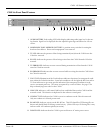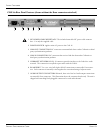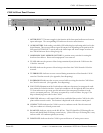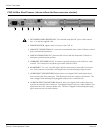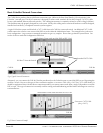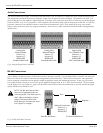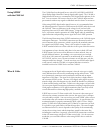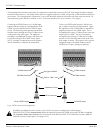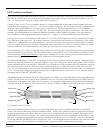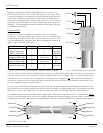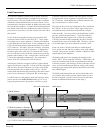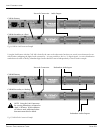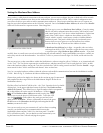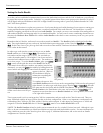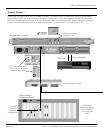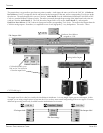
CAB
™
16 Series User Manual
Page 26 http://aa.peavey.com copyright 2000 All Rights Reserved
CAT 5 cable is your friend....
Well, you’ve been in the audio business for a while now....you know all about audio connections, balanced cables, multi-pairs,
SJO, TRS this and XLR that....you can dress off a wiring harness like nobody’s business....then, the industry throws “CAT 5” at
you....! So, what exactly is Category 5 cabling, and how do I terminate it?
Category 5 cable, or “CAT 5” as it is commonly known, is a wiring standard that became popular when computer networks
moved from a “bus” topology to a “star” or...... “every box is a home run” topology. The wire itself consists of 8 conductors, iden-
tified into 4 pairs, and although only two of these pairs are actually used, all four are terminated. It is a UTP (Unshielded
Twisted Pair) configuration, in true telco, or AT&T style. The cable is coupled to in-line RJ-45 connectors, also a Bell/AT&T
standard. Special crimping tools are required to make the termination, and are available everywhere, as are the connectors.
Oh...and before you start designing cable plants for small cities....a single CAT 5 cable run should not exceed 100 meters.
Just like telco wire, there are stranded and solid varieties of CAT 5 cable. This is important to know, because the RJ-45 connec-
tor is different for each type of wire. The standard “bent tyne” style connector is intended for use with solid core wire, and the
“aligned tyne” connector is for use with standard wire. There have been errors when using incorrect cable/connector combina-
tions, so be careful. The "bent tyne" connector will generally work on stranded wire by the way, but not the other way around.
In general, make sure your connector matches your cable type. If you aren’t sure, use the “bent tyne” variety.
When terminating CAT 5 cable, it is important that the natural twist of each pair be carried through as close as possible to the
point of termination at the connector. The EIA standard requires no more than 1/2 inch be left untwisted. More than 1/2 inch
of untwisted cable will affect performance
at high bit rates. Although only 2 of the 4 twisted pairs are used for Ethernet, it is
important that all pairs be terminated, and that the conductors be twisted together in pairs.
The illustrations should give you the basics for getting your cables, and your audio system up and running. Although pre-made,
molded style cables are preferred, they are usually impractical, since your cabling route, distance and locations are based on the
jobsite conditions and not your test bench. Additionally, you will need rack wiring, and bulk cable is the preferred way to dress
off a wire harness, as we all know. Since this manual is printed in grayscale, you will not be able to see the color code of the
wire. We have labeled them for your convenience, but you should get familiar with the color schemes so they are second nature
to you. An error in the cabling of your audio network is often the primary cause of system errors, so....take your time, learn it
thoroughly and DO IT RIGHT THE FIRST TIME!
Although the wiring standard used in CAT 5 cabling originates with AT&T, it is functionally different for configuring ethernet
cabling. The Bell System uses a series of colors to indentify wire pairs. This color scheme identifies the pair numbers, and con-
ductor polarity, and applies to the WIRE....not the connector. It is important to know what pairs are which, and the function
of the pins on the RJ-45 connector. The colors are BLUE, ORANGE, GREEN and BROWN for the first four pairs. The color
code extends well beyond that, but since we are only dealing with 4 pairs of wire, you don’t need to know the entire Bell
System color code for terminating a 900 pair distribution trunk...! What is often confusing is that the pair numbers do not line
up with the pin numbers on the RJ-45 connector. In other words, conductor ONE of the cable (White w/Blue Strip) is NOT
terminated to PIN ONE of the connector. The AT&T connecting standard always uses the middle pins for the first pair. After
that, they are staggered around, primarily to prevent crosstalk between adjacent pairs. For ethernet, and for use with the CAB
16, only the ORANGE and GREEN pairs are actually used. BUT...it is very important that you build the cable with ALL PAIRS
properly terminated. This will prevent any confustion later, and give your cable a solid mechanical connection.
Fig. 9, Standard “normal” CAT 5 cable
Blue Pair
Orange Pair
Green Pair
Brown Pair
Pin 1
Pin 8
Pin 8
Pin 1
Blue Pair
Brown Pair
Green Pair
Orange Pair



